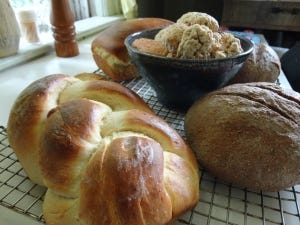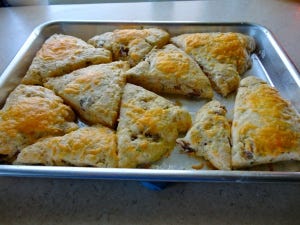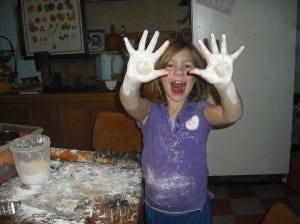Glorious Gluten

Challah, Russian Black Bread, and oatmeal cookies. Gluten has been getting a bad rap recently, as the new wave of fad dieting sweeps the land, and it's all the rage to be allergic to gluten. The problem is, a lot of people don't even know what gluten is, what it does, and why they think they can't digest it is beyond me. Look, celiac runs in my family. I have people who really can't eat gluten, and I'm likely to wind up doing some gluten-free cooking from time to time because I love them. But mostly when I hear a discussion on the 'net about eating gluten-free, I roll my eyes and move on. The Encyclopedia Brittanica says "Gluten: a yellowish gray powdery mixture of water-insoluble proteins occurring in wheat and other cereal grains and composed chiefly of the proteins gliadin and glutenin. Its presence in flour helps make the production of leavened, or raised, baked goods possible because the chainlike molecules form an elastic network that traps carbon dioxide gas and expands with it. Gluten is also found in special high-protein breakfast foods and other cereal foods and is used in adhesives and as meal for cattle food. It also may be used in the manufacture of certain amino acids, including glutamic acid and its salt, the seasoning agent monosodium glutamate.
The properties of gluten vary according to its composition, which differs according to the source. The variations govern the baking qualities of flours, as is shown by the properties of doughs prepared from different kinds of wheat flours; i.e., the dough can be soft and extensible or tough and elastic, or have properties between the extremes." (Copyright © 1994-2014 Encyclopædia Britannica, Inc.)
So now we know it's a protein. That's right, just like meat and soy, and a bunch of other nutrients our body needs to fuel our daily life. Given that bread has been celebrated as the staff of life almost as long as there has been written history, I doubt very much that gluten is suddenly toxic to a large slice of human population.
Quickly glancing at actual scientific studies, not popular media articles, I find some very interesting results that confirm my gut reaction to the phenomenon of Non-Celiac Disease gluten intolerance syndrome. Gastroenterology published this paper, No Effects of Gluten in Patients With Self-Reported Non-Celiac Gluten Sensitivity After Dietary Reduction of Fermentable, Poorly Absorbed, Short-Chain Carbohydrates: "Gluten-specific effects were observed in only 8% of participants. There were no diet-specific changes in any biomarker. During the 3-day rechallenge, participants' symptoms increased by similar levels among groups. Gluten-specific gastrointestinal effects were not reproduced. An order effect was observed. CONCLUSIONS: In a placebo-controlled, cross-over rechallenge study, we found no evidence of specific or dose-dependent effects of gluten in patients with NCGS placed diets low in FODMAPs" (Biesiekierski, JR, et al. "No Effects Of Gluten In Patients With Self-Reported Non-Celiac Gluten Sensitivity After Dietary Reduction Of Fermentable, Poorly Absorbed, Short-Chain Carbohydrates." Gastroenterology 145.2 (n.d.): 320-+. Science Citation Index. Web. 4 July 2014.)
A survey of patients in Italy found that most patients who claimed to be sensitive to gluten were adult females who complained of symptoms within hours of ingesting the gluten, and in the vast majority of cases, there were no biomedical markers discovered that could indicate an actual condition. Some were discovered to have signs of a condition (mostly related to IBS) but as you will see, the percentage of those is very small, about three percent of the population of the study. (Volta, Umberto, et al. "An Italian Prospective Multicenter Survey On Patients Suspected Of Having Non-Celiac Gluten Sensitivity." BMC Medicine 12.1 (2014): 42-61. Academic Search Premier. Web. 4 July 2014.)

Note that CD and other gluten sensitivites are a tiny percentage of the surveyed patients.
Another study points out that although Non-Celiac Gluten Sensitivity is now recognized, they still aren't sure what it is, or where it comes from. "Celiac disease is an immune-mediated in ammatory disorder of the small intestine caused by sensitivity to dietary gluten and related proteins in genetically predisposed individuals. Over the past several years, the concept of non-celiac gluten sensitivity (NCGS) has gained signi cant interest from the scienti c community and mass media and the number of individuals embracing a gluten-free diet is rapidly growing. is condition is characterized by gastrointestinal or extraintestinal symptoms that respond to gluten withdrawal without evidence for underlying celiac disease or wheat allergy. Symptoms display signi cant overlap with the irritable bowel syndrome. Many important factors regarding this relatively novel condition remain to be elucidated; no discriminative markers to support a diagnosis of gluten sensitivity have been identi ed yet and its pathogenesis remains obscure." (Nijeboer, Petula, et al. "Non-Celiac Gluten Sensitivity. Is It In The Gluten Or The Grain?." Journal Of Gastrointestinal & Liver Diseases 22.4 (2013): 435-440. Academic Search Complete. Web. 4 July 2014.)
I am very much not one to go in for fad diets. I never have been, and my motto when eating is "all things in moderation." Although I discovered a couple of years ago I can no longer drink milk, I also found that the knee-jerk reaction of eliminating all lactose from my diet wasn't necessary, either. I just needed to not eat a lot of dairy at a go, and taking some supplemental enzymes to help my gut break down the sugar (which is what lactose is, it's a type of sugar molecule) helps as well.
So we know what gluten is, now, what does it DO?

The finished scones, so rich, flaky, and delicious!
Gluten makes bread, biscuits, pasta, pie, cookies, and all manner of good food possible. It's the glue of anything ordinarily made with flour. Once activated in dry flour by the addition of water, and the action of kneading, the protein becomes like a whole bunch of bungie cords all tangled together. This is what gives French Bread, for instance, that delightfully chewy texture. Without gluten, as those who must do without have discovered, everything crumbles, like a shortbread cookie.
So every time you eat a slice of toast, or pour syrup on a pancake, but especially when you enjoy warm, fresh bread, think about the proteins that make it possible. Glorious gluten… supporting the staff of life since the Pharoahs built the pyramids, and beyond.
I'm baking today!
French Bread
1 ½ c warm water
2 tsp sugar
2 ¼ tsp yeast
1 tsp salt
4 c flour
In your stand mixer if you have one, or in a large bowl, combine the water, sugar, and yeast. Allow to stand and let the yeast wake up and start to eat and multiply again after their forced dormancy. I usually give it 5-10 minutes while I'm doing other things. Put the dough hook on the mixer, and start it at low speed. If you're working manually, a wooden spoon works fine. Add the flour slowly, I usually do a cup at a time, and throw the salt in there with the first cup of flour. The salt isn't for flavor so much as to retard the growth of the yeast when it starts to really party and get carried away. Keep mixing until you have formed a stiff ball of dough. It might not take the whole 4 cups, so go slow there at the end. Allow the mixer to run at slow or medium speed for 7-10 minutes, or knead by hand for that long. What's happening here is that you are waking the gluten up, really getting it going, so you have that chewy texture we associate with french bread. For a more tender, soft bread, don't knead for this long. Cover, and allow to double in size. I usually do this right on the mixer, having lifed the dough hook out of the way. Once it has doubled, turn out onto a floured surface and knead again. Just long enough to flatten most of the air bubbles out of the dough. Cover, and let rise again. When it has risen for abot 20 minutes (times will vary wildly depending on how warm your kitchen is, and how frisky your yeast gets), punch down lightly (not a full knead, just the big bubbles) and form into loaves. I usually get two long, skinny loaves out of this recipe. You could get a whole lot of breadsticks, or a couple of pizza crusts… it's pretty versatile. Put the loaves on a greased cookie sheet, or baking stone, and allow to rise for a final time, until almost doubled. Preheat the oven to 400° while this is happening. If you like the really crusty french loaf, brush them with a bit of egg white and water. We don't, we prefer what's called Italian, so I skip this bit, although I will oil or butter them. Bake for 20-25 minutes. Bread is done when it sounds hollow when tapped. Remove, and cool if your family can keep their mitts off it that long. Tonight, I will serve this along with chicken and salad for a light summer dinner.

Flour Monster! tasty gluten!



